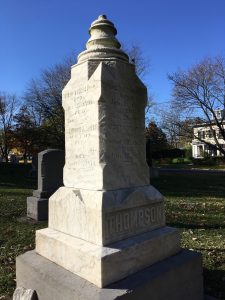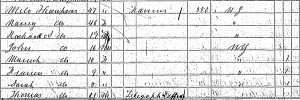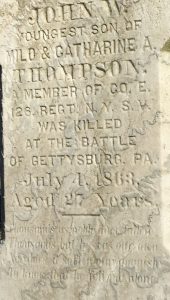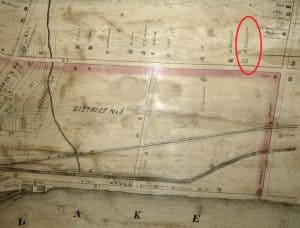The Thompson Family of Washington Street Cemetery
By Anne Dealy, Director of Education and Public Information
It is now October and this is the month when we run our Cemetery Stories school program. Five years ago, I wrote about the process we go through with students on this field trip to help them understand how historians find (or don’t find!) answers to their questions. We run the program at Washington Street Cemetery, and students learn about a few of the families buried there. The cemetery represents a Geneva that was very different from the one that they live in. Most of the marked burials are are of white Protestant members of the village population. Catholics were buried at St. Patrick’s Cemetery. As far as we know, no people of other religious traditions lived in Geneva in the early in the 1800s. There are a few important Black families interred in the cemetery, but overall, the burials reflect a community that was much more homogeneous than today. Like the cemetery, the village was much smaller—less than half today’s population. Although Geneva was not diverse in the way we think of that word today, the cemetery shows the wide variety of circumstances that people lived and died in. Researching burials there is a lesson in what history can tell you and the many stories of ordinary people that remain untold.
One of the families that the fifth-grade students investigate on their visit is the Thompson family. They have a modest-sized monument near the Washington Street entrance, and eight family members are listed on the stone. The head of the household was Milo Thompson, a farmer. His wife was Catherine. Buried in the family plot are their sons John and Thomas, and their four daughters, Rachel, Sarah Helen, Maria, and Frances. The family’s home was on the northwest corner of Preemption Street and North Street/Border City Road. There is a long inscription for their son John, as he was one of the many young men of the 126th regiment killed at Gettysburg with Col. Eliakim Sherrill in 1863. The monument must have been erected at his death.
Milo Thompson died in 1872 after a long period as an invalid. Mrs. Thompson died two years later, and their daughters continued to live in the house. Thomas Thompson apparently lived Dunkirk, New York and worked for the Erie Railroad. He died of typhoid fever in 1881, unmarried. Only Maria married, and she was the second wife to an older man from Dunkirk. A former hotel manager, he left her a widow in Detroit after six years. Maria doesn’t seem to have had children and apparently returned to Geneva to live with her unmarried sisters after his death. According to the census, the sisters variously worked as schoolteachers, dressmakers, and milliners. Rachel and Helen were the only ones listed in a Geneva Directory and the entry gave no occupation. Ten years after their brother Thomas’s death they sold the family property and left the area for New Jersey. The census listed New Jersey as the place of birth for Milo, his wife, and several of the children, so they likely had relatives there.
This information is more than you will find on many people buried in historic cemeteries. Milo Thompson was known to Stephen and Edgar Parker, editors of several Geneva newspapers. They mentioned the family in the newspapers on occasion, but I had more questions that I couldn’t answer about the Thompsons. For one, I could not find any record of Milo’s purchase of the property on Border City Road in the county property records. The only reference to that area was a 3-acre lot sold by his daughters in 1890. The deed indicated they had acquired it from Thomas, presumably through inheritance. He had purchased it from a Royal Thompson in Ithaca, the city where two of the Thompson daughters were born. There were no records of purchases by Milo Thompson in Ontario County. Second, how could he have made a living farming a 3-acre piece of land? He is listed in the 1867-68 Ontario County Directory as a farmer with a 4-acre property, so the piece the daughters sold seems to be most of the land. Unlike the ubiquitous John Johnston, I couldn’t find any references to Thompson in online agricultural periodicals or the newspaper accounts of entrants to the county fair. Third, how did the daughters make a living for the 18 years after their father died? Did they work in the occupations listed on the earlier census? Did Maria inherit money from her husband? Did their brother or another family member support them? Did they live in poverty as so many unmarried women did then, especially as they aged? Finally, is Frances buried in the plot? There is no death date listed for her on the stone. If she isn’t here, why wasn’t her body returned to the family plot?
It turned out that with a little digging in online records, the question of the property can be guessed at. Following up on Royal Thompson, I found he was a substantial landowner and farmer in Ithaca and that he purchased the property the Thompson family occupied in Geneva. He then conveyed it to Thomas Thompson upon Milo’s death. Royal was probably a relative of Milo’s, perhaps a brother, as they were similar in age. They had also both once lived in Ithaca. As for Frances, she moved earlier than her sisters since she is not listed in the census for Geneva in 1875 or later. The Geneva newspaper reported that she was matron of the Paterson (NJ) Orphan Asylum in 1894 where she was robbed by a man impersonating a telephone repair person. In 1915, she was listed in the Passaic, New Jersey census, which is the last trace I found of her.
Following trails like this is what makes genealogy appealing to so many people. With the abundance of online records, it can be an armchair hobby for anyone with an internet connection. It’s what we hope to intrigue students with when they visit Washington Street Cemetery. You don’t even have to research your own family to enjoy hunting down traces of people’s lives. Although the Thompsons only left a monument behind in the cemetery, you can piece together quite a bit of their story—though it also shows that the more you learn, the more questions you have, and there are always some you won’t be able to answer.






Good story and interesting research you did.
Genealogy is fascinating especially today with what you can study online.
Thanks Anne